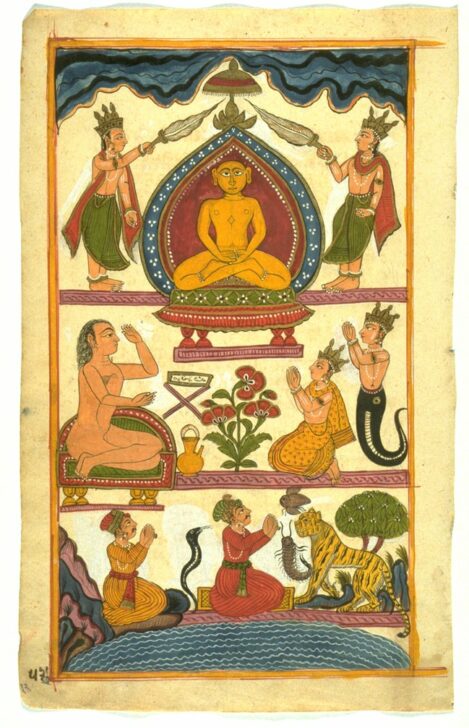Digambara Jain manuscript page: Jina venerated by a monk and a royal devotee
Artist Unknown, India, Rajasthan, Sirohi School

Description
Jina are always depicted standing or seated in padmasana pose. This painting shows a “sky-clad,” or nude, Jina meditating peacefully with his legs crossed. All other figures in the image appear in full profile—a style that became popular by the end of the sixteenth century due to contact with Mughal art and its traditions of naturalistic portraiture. Prior to this, Jain art used three-quarter profile depictions of people known as “protruding eye,” because the head would be slightly turned to allow a view of both eyes. Seated below the Jina is a monk with a bookstand before him, indicating that he is teaching the royal patrons across from him.
Fall 2010 Gallery Rotation, Natsu Oyobe, April 2010
Gallery Rotation Fall 2010
Jina venerated by a monk and a royal devotee from a Digambara Jain manuscript
India, Rajasthan, Sirohi
18th century
Ink, opaque watercolor, and gold on paper
Gift of Dr. and Mrs. Leo S. Figiel and Dr. and Mrs. Steven J. Figiel, 1975/2.167
Jina are always depicted standing or seated in padmasana pose. This painting shows a “sky-clad,” or nude, Jina meditating peacefully with his legs crossed. All other figures in the image appear in full profile—a style that became popular by the end of the sixteenth century due to contact with Mughal art and its traditions of naturalistic portraiture. Prior to this, Jain art used three-quarter profile depictions of people known as “protruding eye,” because the head would be slightly turned to allow a view of both eyes. Seated below the Jina is a monk with a bookstand before him, indicating that he is teaching the royal patrons across from him.
Subject Matter:
The dedication of sacred manuscript books for shrines is required of Jain devotees, and book production reflects the integral relationship among the laity, monastic community, and the Jina. Commissioning a book fulfills the lay obligation of charity, while beholding a book helps the individual achieve the proper mental state for spiritual guidance.
Jina are always depicted standing or seated in padmasana pose. This painting shows a “sky-clad,” or nude, Jina meditating peacefully with his legs crossed. All other figures in the image appear in full profile—a style that became popular by the end of the sixteenth century due to contact with Mughal art and its traditions of naturalistic portraiture. Seated below the Jina is a monk with a bookstand before him, indicating that he is teaching the royal patrons across from him.
Physical Description:
This is a brightly colored painting on a light background. It depicts a three- tiered scene with several figures, standing and kneeling, looking toward a central seated figure in the top tier. This male figure is seated in lotus position on a throne, decorated with colorful designs. To his left and right are attendants who fan him. In the middle tier, there is a nude man with long hair, a kneeling woman and a figure who is half-man and half-serpent. In the bottom tier, there are two kneeling men, wearing robes and headdresses, with hands pressed together and eyes gazing upward toward the main figure. They are surrounded by a tiger, a bird, an insect and a serpent.
Usage Rights:
If you are interested in using an image for a publication, please visit https://umma.umich.edu/request-image/ for more information and to fill out the online Image Rights and Reproductions Request Form.